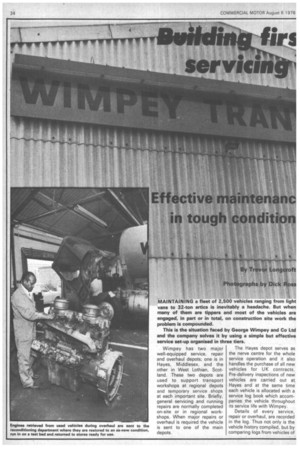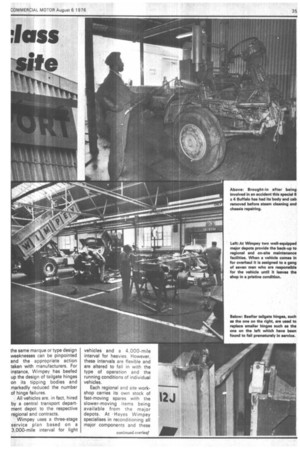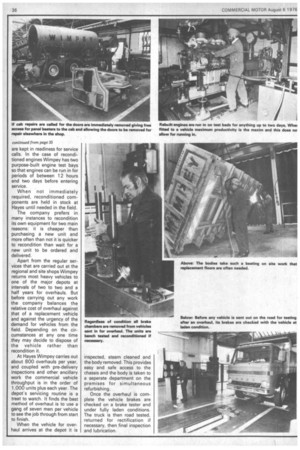Ef ective maintenand
Page 36

Page 37

Page 38

If you've noticed an error in this article please click here to report it so we can fix it.
in tough condition
MAINTAINING a fleet of 2,500 vehicles ranging from light vans to 32-ton artics is inevitably a headache. But when many of them are tippers and most of the vehicles are engaged, in part or in total, on construction site work the problem is compounded.
This is the situation faced by George Wimpey and Co Ltd and the company solves it by using a simple but effective service set-up organised in three tiers.
Wimpey has two major well-equipped service, repair and overhaul depots; one is in Hayes, Middlesex, and the other in West Lothian, Scotland. These two depots are used to support transport workshops at regional depots and temporary service shops at each important site. Briefly, general servicing and running repairs are normally completed on-site or in regional workshops. When major repairs or overhaul is required the vehicle is sent to one of the main depots. The Hayes depot serves as the nerve centre for the whole service operation and it also handles the purchase of all new vehicles for UK contracts. Pre-delivery inspections of new vehicles are carried out at Hayes and at the same time each vehicle is allocated with a service log book which accompanies the vehicle throughout its service life with Wimpey.
Details of every service, repair or overhaul, are recorded in the log. Thus not only is the vehicle history compiled, but by comparing logs from vehicles of the same marque or type design weaknesses can be pinpointed and the appropriate action taken with manufacturers. For instance, Wimpey has beefed up the design of tailgate hinges on its tipping bodies and markedly reduced the number of hinge failures.
All vehicles are, in fact, hired by a central transport department depot to the respective regional and contracts.
Wimpey uses a three-stage service plan based on a 3,000-mile interval for light vehicles and a 4,000-mile interval for heavies. However, these intervals are flexible and are altered to fall in with the type of operation and the running conditions of individual vehicles.
Each regional and site workshop carries its own stock of fast-moving spares with the slower-moving items being available from the major depots. At Hayes Wimpey specialises in reconditioning all major components and these are kept in readiness for service calls. In the case of recondi tioned engines Wimpey has two purpose-built engine test bays so that engines can be run in for periods of between 12 hours and two days before entering service.
When not immediately required, reconditioned components are held in stock at Hayes until needed in the field.
The company prefers in many instances to recondition its own equipment for two main reasons: it is cheaper than purchasing a new unit and more often than not it is quicker to recondition than wait for a new unit to be ordered and delivered.
Apart from the regular services that are carried out at the regional and site shops Wimpey returns most heavy vehicles to one of the major depots at intervals of two to two and a half years for overhauls. But before carrying out any work the company balances the relative cost of overhaul against that of a replacement vehicle and against the urgency of the demand for vehicles from the field. Depending on the cir cumstances at any one time they may decide to dispose of the vehicle rather than recondition it.
At Hayes Wimpey carries out about 800 overhauls per year, and coupled with pre-delivery inspections and other ancillary work the commercial vehicle throughput is in the order of 1,000 units plus each year. The depot's servicing routine is a treat to watch. It finds the best method of overhaul is to use a gang of seven men per vehicle to see the job through from start to finish.
When the vehicle for overhaul arrives at the depot it is inspected, steam cleaned and the body removed. This provides easy and safe access to the chassis and the body is taken to a seperate department on the premises for simultaneous refurbishing.
Once the overhaul is complete the vehicle brakes are checked on a brake tester and under fully laden conditions. The truck is then road tested, returned for rectification if necessary, then final inspection and lubrication.




















































































